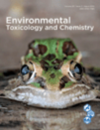Temperature and food concentration have limited influence on the mixture toxicity of copper and Microcystis aeruginosa to Daphnia magna
 Harmful algal blooms, produced by cyanobacteria, not only impact water quality, but they also have the potential to produce toxins that can harm humans, pets and wildlife. The blooms are caused by a combination of factors, one major factor being warmer temperatures. 2015 was the warmest year on record. Before that it was 2014. The five warmest years (i.e., since records have been kept) all occurred since 2005 and since 1998, 15 years have tied or set global heat records. Taking the hard facts into account it cannot be denied that we are looking into a long-term trend of rising temperatures, likely to further promote the global expansion of cyanobacteria. As copper is commonly used as an algaecide to eradicate cyanobacterial blooms we investigated the combined effects of copper and the toxin-producing cyanobacterium Microcystis aeruginosa and how these were affected by temperature and total food concentration. Two commonly used ‘reference’ models (concentration addition and independent action) were used to test if it is possible to predict toxicity in these mixtures. In this study, it was found that concentration addition not only predicted the combined effects more accurately than independent action but moreover that it was the most “safe” (conservative) model. Our study shows that the interactive effects between copper and harmful algae blooms are not overly dependent on temperature and total food concentration, as both factors together only explained 11% of the variance while the effects of M. aeruginosa explained 76% of the variance in the copper median effective concentration for reproduction of the model organism Daphnia magna. Nevertheless the present study warns against the use of copper-based algaecides and suggests that environmental risk assessment of copper should consider specific situations where harmful M. aeruginosa blooms can co-occur with elevated copper exposure.
Harmful algal blooms, produced by cyanobacteria, not only impact water quality, but they also have the potential to produce toxins that can harm humans, pets and wildlife. The blooms are caused by a combination of factors, one major factor being warmer temperatures. 2015 was the warmest year on record. Before that it was 2014. The five warmest years (i.e., since records have been kept) all occurred since 2005 and since 1998, 15 years have tied or set global heat records. Taking the hard facts into account it cannot be denied that we are looking into a long-term trend of rising temperatures, likely to further promote the global expansion of cyanobacteria. As copper is commonly used as an algaecide to eradicate cyanobacterial blooms we investigated the combined effects of copper and the toxin-producing cyanobacterium Microcystis aeruginosa and how these were affected by temperature and total food concentration. Two commonly used ‘reference’ models (concentration addition and independent action) were used to test if it is possible to predict toxicity in these mixtures. In this study, it was found that concentration addition not only predicted the combined effects more accurately than independent action but moreover that it was the most “safe” (conservative) model. Our study shows that the interactive effects between copper and harmful algae blooms are not overly dependent on temperature and total food concentration, as both factors together only explained 11% of the variance while the effects of M. aeruginosa explained 76% of the variance in the copper median effective concentration for reproduction of the model organism Daphnia magna. Nevertheless the present study warns against the use of copper-based algaecides and suggests that environmental risk assessment of copper should consider specific situations where harmful M. aeruginosa blooms can co-occur with elevated copper exposure.
Scientific abstract
Standard ecotoxicity tests are conducted under constant and favorable experimental conditions. In natural communities, however, the toxicity of chemicals may be influenced by abiotic and biotic environmental factors. Firstly, the authors examined the influence of temperature and total food concentration on the nature of the combined effects of copper (Cu) and the cyanobacterium Microcystis aeruginosa to Daphnia magna (i.e., whether the combined effects deviated from noninteraction). Secondly, the authors investigated the relative influence of the percentage of M. aeruginosa in the diet, temperature, and total food concentration on chronic Cu toxicity to D. magna. The nature of the combined effects between Cu and M. aeruginosa (i.e., synergism according to the independent action reference model and noninteraction according to concentration addition reference model) was not affected by temperature and total food concentration. In line with other studies, the concentration addition reference model gave rise to more protective predictions of mixture toxicity than the independent action reference model, thus confirming the former model's suitability as a conservative scenario for evaluating mixture toxicity of Cu and M. aeruginosa under the temperature and food concentrations tested. Further, the 21-d median effective concentration for Cu based on reproduction varied between 20 μg/L and 100 μg/L, and the results indicate that the percentage of M. aeruginosa explained 76% of the variance in the Cu median effective concentration for reproduction, whereas the effects of temperature and total food were limited (together explaining 11% of the variance). The present study suggests that environmental risk assessment of Cu should consider specific situations where harmful M. aeruginosa blooms can co-occur with elevated Cu exposure.
Full reference (link)
Hochmuth J, Janssen C, De Schamphelaere K. Temperature and food concentration have limited influence on the mixture toxicity of copper and Microcystis aeruginosa to Daphnia magna. Environmental Toxicology and Chemistry, 35, 742-749.
